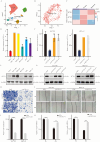SCYL1-mediated regulation of the mTORC1 signaling pathway inhibits autophagy and promotes gastric cancer metastasis
- PMID: 39394539
- PMCID: PMC11469978
- DOI: 10.1007/s00432-024-05938-5
SCYL1-mediated regulation of the mTORC1 signaling pathway inhibits autophagy and promotes gastric cancer metastasis
Abstract
Background: The SCY1-like (SCYL) family has been reported to be closely related to cancer metastasis, but it has not been reported in gastric cancer (GC), and its specific mechanism is not clear.
Methods: We utilized databases like Deepmap, TCGA, and GEO to identify SCYL1's role in GC. Clinical samples were analyzed for SCYL1 expression and its correlation with patient prognosis. In vitro and in vivo experiments were conducted to assess SCYL1's function in GC cell migration, invasion, and autophagy.
Results: SCYL1 showed an increased expression in GC tissues, which correlated with a negative prognosis. In vitro experiments demonstrated that SCYL1 promotes GC cell migration and invasion and inhibits autophagy. GSEA indicated an inverse relationship between SCYL1 and autophagy, while a direct relationship was observed with the mTORC1 signaling pathway. Knockdown of SCYL1 enhanced autophagy, while activation of mTORC1 reversed this effect.
Conclusions: SCYL1 is a significant contributor to GC progression, promoting metastasis by activating the mTORC1 signaling pathway and inhibiting autophagy. These findings suggest SCYL1 as a potential therapeutic target for GC treatment.
Keywords: Autophagy; Gastric cancer; Metastasis; SCYL1; mTORC1.
© 2024. The Author(s).
Conflict of interest statement
The authors declare that the research was conducted in the absence of any commercial or financial relationships that could be construed as a potential conflict of interest.
Figures






Similar articles
-
EYA3 promotes the tumorigenesis of gastric cancer through activation of the mTORC1 signaling pathway and inhibition of autophagy.Sci Rep. 2024 Nov 16;14(1):28355. doi: 10.1038/s41598-024-80027-8. Sci Rep. 2024. PMID: 39550476 Free PMC article.
-
STAT3-induced lncRNA HAGLROS overexpression contributes to the malignant progression of gastric cancer cells via mTOR signal-mediated inhibition of autophagy.Mol Cancer. 2018 Jan 12;17(1):6. doi: 10.1186/s12943-017-0756-y. Mol Cancer. 2018. PMID: 29329543 Free PMC article.
-
Downregulation of NUSAP1 suppresses cell proliferation, migration, and invasion via inhibiting mTORC1 signalling pathway in gastric cancer.Cell Biochem Funct. 2020 Jan;38(1):28-37. doi: 10.1002/cbf.3444. Epub 2019 Nov 11. Cell Biochem Funct. 2020. PMID: 31710389
-
SIK2 represses AKT/GSK3β/β-catenin signaling and suppresses gastric cancer by inhibiting autophagic degradation of protein phosphatases.Mol Oncol. 2021 Jan;15(1):228-245. doi: 10.1002/1878-0261.12838. Epub 2020 Nov 20. Mol Oncol. 2021. PMID: 33128264 Free PMC article.
-
Silencing of RNFT2 suppresses cell proliferation and migration through mTORC1 signaling pathway in gastric cancer.Amino Acids. 2025 Mar 18;57(1):19. doi: 10.1007/s00726-025-03449-2. Amino Acids. 2025. PMID: 40097779 Free PMC article.
References
-
- Aslan C, Maralbashi S, Salari F, Kahroba H, Sigaroodi F, Kazemi T et al (2019) Tumor-derived exosomes: Implication in angiogenesis and antiangiogenesis cancer therapy. J Cell Physiol 234(10):16885–16903 - PubMed
-
- Chen Y, Wang B, Zhao Z, Li M, Wang F (2022) PRSS2 overexpression relates to poor prognosis and promotes proliferation, migration and invasion in gastric cancer. Tissue Cell 79:101949 - PubMed
MeSH terms
Substances
Grants and funding
- KYCX24_3580 and SJCX24_2055/Postgraduate Research and Practice Innovation Program of Jiangsu Province
- KYCX24_3580 and SJCX24_2055/Postgraduate Research and Practice Innovation Program of Jiangsu Province
- 82102720/National Natural Science Foundation of China
- JC12022107/Science and Technology Bureau of Nantong
- JC2023092/Natural Science Foundation of Nantong Municipality
LinkOut - more resources
Full Text Sources
Medical
Molecular Biology Databases
Miscellaneous

